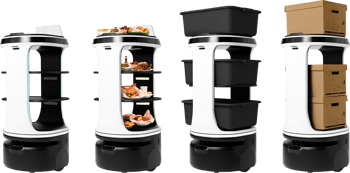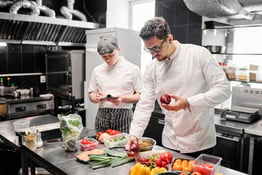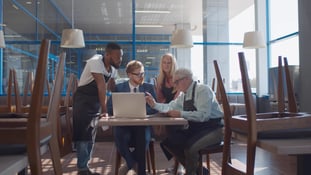The use of automation and robotics in restaurants is becoming increasingly commonplace across the industry. From fast food chains with robotic kitchen workers to coffee shops with mechanical baristas, robotics is driving innovations in food prep, customer service, delivery, and more.
In fact, robotics is among the fastest growing restaurant technology trends as operators look for creative ways to reduce costs and solve pressing labor shortage issues. Indeed, there is some evidence that robotics in restaurants may offer a solution to both of these challenges.
According to an article from global restaurant consultant Aaron Allen and Associates, restaurants that adopt robotics-based solutions may be able to save anywhere between 30 and 70 percent on labor costs.
The article from Aaron Allen & Associates points out that we are still in the very early stages of adoption. However, a number of notable brands are already exploring the potential benefits of robotics in restaurants.
10 National Chains Embracing Robotics in Restaurants
Here are ten recognizable brands that are taking the lead on robotics-based restaurant technology trends.
1. White Castle
White Castle introduced Flippy in 2020. The robotic fry cook contributed to a dramatic improvement in efficiency and was rapidly deployed across more than 100 White Castle locations as well as at smaller chains including CaliBurger, in Pasadena.
Flippy was created by Miso Robotics, a leading innovator in the area of robotics in restaurants. Flippy is essentially a sous chef that cooks and flips burgers with a spatula, freeing up time for human chefs to manage more complex tasks in the kitchen while reducing their risk of cuts and burns.
White Castle recently introduced the next generation robotics solution Flippy 2, which it plans to implement in roughly 350 of its U.S. locations.
2. Chipotle
Another Miso creation, Flippy Lite was designed “to focus on a single product that needs seasoning and finishing.” Chipotle viewed the bot as a perfect solution for automated preparation of its popular tortilla chips.
Dubbing the machine Chippy, Chipotle noted that the robotics solution wouldn’t replace its workers. Instead, Chippy was designed to unburden kitchen workers of the repetitive, monotonous, and enormous daily task of preparing tortilla chips.
Along the same lines, Chipotle is also currently testing a machine called Hyphen. Hyphen focuses on collaborative robotics in restaurants, providing automated solutions that work alongside people.
The purpose of Hyphen is to assist human workers, especially during peak hours, so that they can focus on providing excellent customer service and improving the customer experience. Chipotle plans to use Hyphen to help team members prep salad and burrito bowls, which account for 65 percent of its digital orders.
3. Buffalo Wild Wings
In 2021, Miso unveiled a robot called Flippy Wings, which was specifically designed to aid in the preparation of chicken wings. According to Miso, “Wingy” was built to “maximize the number of wings that are cooked while minimizing the time that takes and the waste it makes.”
Wingy fries the wings for a certain length of time before lifting them out of the fryer and placing them in a holding area. It proved a perfect solution for Buffalo Wild Wings. The sports bar chain implemented Wingy in select stores and quickly saw a 10-20% improvement in its productive speed.
4. Panera Bread
In 2022, Panera Bread became the first nationwide chain to deploy the CookRight Coffee system. Another Miso Robotics invention, CookRight is an automated coffee brewing system. For Panera, says chief digital officer George Hanson, using CookRight isn’t about cutting labor costs. To the contrary, it’s about freeing up employees to do what they do best — provide excellent customer service and enhance the consumer experience.
While Hanson doesn’t envision a future in which Panera is totally automated, he acknowledges that robotics in restaurants can help improve the overall customer experience and that the chain will consider adopting robotics solutions that it believes can do so.
5. Sweetgreen
In contrast to Panera, Sweetgreen CEO Jonathan Neman said during a recent tech conference panel that he anticipates most of the salad chain’s locations will be fully automated in the not-too-distant future.
In 2021, Sweetgreen acquired a venture called Spyce. Designed by a quartet of MIT students, Spyce was a Boston fast-casual eatery with a fully automated robotic kitchen. In the time since, Sweetgreen has transformed this technology into the Infinite Kitchen.
In early 2024, Sweetgreen tested the automated kitchen tech in a few select locations and saw average tickets at those units that were over 10 percent higher than in surrounding markets. As per Neman’s push for total automation, we can expect to see a continued rollout of the Infinite Kitchen in locations across the national chain.


Subscribe to Our Monthly Operations Newsletter
Learn how to streamline your processes, cut costs, and run a more efficient restaurant.
6. Chili’s
While many of the restaurant technology trends cited above focus on back of house solutions, Chili’s is taking a lead on implementing customer-facing robotic innovations. In 2020, the fast-casual chain began testing Rita the Robot, its nickname for a Bear Robotics creation called Servi.
The automated service robot can escort guests to tables, run food, take dishes to the kitchen, and play a happy birthday tune on command. After testing in 10 locations, Chili’s introduced Rita to 51 locations in 2022.
7. Bionic Bar on Royal Caribbean Ships
Royal Caribbean Cruise Ships have helped Makr Shakr test its line of robotic bartenders. With locations on nine cruise ships, the Bionic Bar ranks among the most stylish uses of robotics in restaurants. According to Makr Shakr, the mechanical bartender received training in movement from New York Theatre Ballet choreographer Marco Pelle.
Patrons at the Bionic Bar can use a mobile app on their phone to place orders, then wait at the bar while Makr Shakr does the rest. Following a successful test at sea, Makr Shakr is currently working to introduce the Bionic Bar on land with initial locations in Singapore, Bali, Texas, and Washington state.
8. Domino’s
Domino’s has been a leader in process automation. The pizza delivery chain pioneered the digital “tracker” system for its online deliveries, installed artificial intelligence to take phone orders, and launched Domino’s Anywhere, allowing customers to place orders via Amazon Alexa and Google Home. These innovations have helped to reinvigorate the Domino’s brand over the last decade.
And in more recent years, Domino’s has experimented behind the scenes with autonomous pizza delivery. Though it has yet to introduce unmanned commercial pizza delivery vehicles, it does currently have an autonomous delivery vehicle in development called DOM.
9. Pizza Hut
Not to be outdone by its closest competitor, Pizza Hut has been testing its own robotics in restaurants across Asia. Through a partnership with SoftBank Robotics, Pizza Hut has introduced a robot called Pepper. Equipped with sensors and AI capabilities, Pepper can take customer orders, engage in conversations, and suggest menu items tailored to individual tastes.
In early tests, Pepper has received positive feedback for its ability to interact with customers and enhance their overall dining experience. Relative to other restaurant technology trends, implementation of Pepper is costly. But Pizza Hut continues to test this technology as a way to differentiate its brand from others in a crowded market.
10. McDonald’s
In 2023, the fast-food giant unveiled its first completely automated location in Fort Worth, Texas. The unmanned restaurant takes customer orders through kiosks; food is prepared by robots; and orders are delivered to customers via conveyor belt.
The automated McDonald’s location demonstrates the potential of robotics in restaurants to handle nearly all of the tasks traditionally handled by human workers while improving speed, efficiency, and accuracy. But it also inspired concern for some consumers, who suggested that supplanting human jobs could dissuade them from patronizing the burger chain.
How Can Restaurant Tech Help You?
This last example underscores the importance of finding a balance between the latest restaurant technology trends and the consumer’s continued desire for a positive customer experience.
While robotics in restaurants presents an opportunity to improve staff efficiency and customer satisfaction, it is just as vital to preserve the traditional dining experiences that consumers desire.
If you’re ready to explore how technology can help you, book a consultation with a Back of House expert today.





